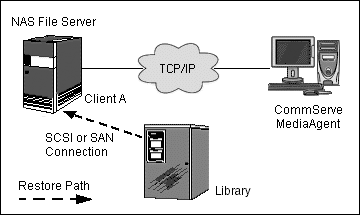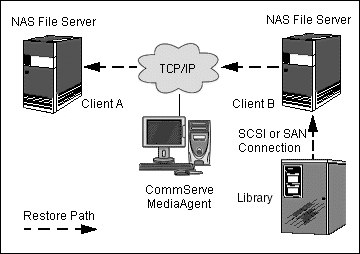Restore Data - NAS NDMP Clients
Topics |
How To |
Full System Restore |
Related Topics
Overview
Browse/Restore Considerations
Vendor Specific
Restore Features
VBB Full Destructive Restore - EMC Celerra only
Additional Advanced
Restore Options for NAS
Restore Destinations
The following page describes the agent-specific restore options. Additional restore options are accessible from the Related Topics menu.
In addition to the available common restore types, there are several restore
types that are specific to the NAS NDMP clients.
General
-
The number of tape drives in use on a particular NAS file server can be
limited through an option in
the
Media Management (Service Configuration) tab. This is useful since some
file servers have an upper limit to the number of concurrent backup or restore jobs
that can be run. The number entered with the Maximum allowed number of drive
reservations per NAS Filer option will limit the number of tape drives that
can be in use at a given time. For example, if five backup jobs were started
for a particular NAS file server, but the number specified with this option was
set to four, then the fifth job will be held in a waiting state until one of the
jobs completes.
- Using Direct Access Restore
(DAR) with Deduplication
may be slower than restoring non-deduplicated data. However, DAR restores
are faster than using non-DAR restore operations.
EMC Celerra
- Direct Access Restore (DAR) only supports No-Image browse/restore.
- Non-DAR restore only supports No-Image browse/restore; even if you
perform an Image browse, the restore will be a No-Image restore.
NetApp
-
To successfully browse and restore data, it is recommended to use the UTF-8
setting for filer volumes. Please consult with NetApp for implications of
changing volume language.
- Only Image browse is supported. DAR and non-DAR restores operate in the
following manner:
- If the root of the backup (i.e., the whole backup) is selected for
restore, an Image restore is performed.
Example:
You have a backup of
/vol/vol0 and you
select /vol/vol0 to restore.
If a directory that is not the root (i.e., not the whole backup) is
selected for restore, a No-Image restore is performed.
Example:
You have a backup of
/vol/vol0 and you
select /vol/vol0/directory1 to restore.
|
Support for the following features vary according to vendor. For more information,
see NAS Vendor Specific
Restore Features
for details.

When data is restored to a NAS NDMP file server from its locally-attached, or
SAN-connected tape drive, this is a two-way restore. In most cases, this is
preferable to a three-way restore, because the restored data does not go across
the network. In the illustration , a restore from the library to Client A is an
example of a two-way restore. Two-way restores can be performed either in-place,
or out-of-place. |

Data can be restored to NAS NDMP file servers which do not have a locally
attached tape drive, from a storage device attached to another NAS NDMP file
server. In the illustration, a restore from the library to Client A is an
example of a three-way restore. This three-way restore process allows many file
servers to share a single, centrally located library, or even restore their data
from a remote site. A three-way restore can be performed in-place, if the data
was backed up using a three-way backup, or out-of-place if it was not; it can
also be restored cross-platform in this manner. When using three way restores,
you cannot restore from one type of NAS file server to a different type of NAS
file server. For example, you cannot restore from an EMC Celerra file server to
a NetApp file server in this scenario. |
Direct Access Restore optimizes the restore operation by allowing the NDMP
client to directly access backed up data anywhere in a tape set without having
to traverse the tape set sequentially. In a
normal restore operation, a large portion of the data from the backup that included
the file must be read. In a Direct Access Restore, only the portion of the tape
which contains the data to be restored is read. This option is available for each
of the NAS NDMP restore types and can save significant time in the restore
operation.
These registry keys are automatically created during installation, to control
the behavior of large Direct Access Restores:
- (Celerra-pre DARTOS 5.5 only) The
nNASDARLIMIT
and
nNASDARPERCENT
registry keys are used in conjunction with the
nRESTORELIMIT registry key to control the size
of the tree before a directory restore is converted from DAR to
non-DAR. When converted to
non-DAR, only the root of
the tree needs to be sent to the Celerra, not the whole tree as in a DAR.
This limit is set at 40,000 by default, and it is recommended to not exceed
that value.
- The
nRESTORELIMIT
registry key (all NAS NDMP clients)
specifies how many files/directory names can be sent in a single restore request; between each request, the tape will be positioned to the start of the
first tape. Thus, a DAR restore of a tree with 24,000 files/directories
would require three restore requests (using the default value of 8192 per request) to be sent to the
NAS file server.
When to use Direct Access Restore
While each environment is different, with many variables that can affect
restore efficiency, making it impossible to define when a Direct Access Restore
will yield best performance, the following guidelines might be of assistance
until speeds can be appropriately evaluated in a specific environment:
- Generally, the smaller the percentage of a given backup that you are
restoring, the greater will be the performance value of using DAR. As the
percentage rises above 30-40%, a non-DAR restore will start to be the faster
choice.
- A Three-way Restore involves more communications overhead between the
library and the NAS file server being restored, and thus sequentially
reading the tape becomes the more efficient choice sooner. Because of this,
you may find that a non-DAR restore is the faster choice even when the
percentage of a given backup being restored is under 30%.
Efficient Non Direct Access Restore
If you are not using direct access restores, restore performance is still optimized
where possible. For instance, if the most recent copy of the data that you want
to restore was backed up by an incremental or differential backup, the restore only
reads the archive file from that differential or incremental backup, instead of
reading the archive files back to the last full backup.
A file system NDMP restore is a cross-platform restore, where the data is
restored to a computer with a different operating system (e.g., ONTAP on a
NetApp NAS NDMP file server) to a file system client with the
File System NDMP
Restore Enabler
installed.
A VBB full destructive restore is an out-of-place restore of a block level
VBB-enabled backup. To accomplish a full destructive restore, the last full backup of an entire specified volume is restored to a raw file system (rawfs)
that is created on
a Celerra file server.
After the out-of-place restore completes, the volume is brought online to a
usable state and an incremental backup can be restored on top of the raw file
system. See
Perform a VBB Full Destructive Restore
for step-by-step instructions.
This option prevents concurrent execution of multiple backup/restore operations on
the same file system, allowing no other backup or restore jobs to run on the
file system while the current job is running. This can be useful in avoiding
possible data inconsistency which can potentially be caused by the following
concurrent operations on the same file system:
- Executing a restore operation during backup processing.
- Executing a backup operation during restore processing.
- Executing another restore operation during restore processing.
Multiple backup operations can be performed simultaneously without any risk
of data loss.
This option allows you to specify that if an item to be restored already exists, that item
will be overwritten by the restored item. When this option is not
selected (the default):
- backed up files/directories whose names are the same as those in
the restore path are not restored unless they are newer than the existing file/directory.
- backed up files/directories whose names are different from those
in the restore path are restored.
Recursive Restore (Agami, Archivas, Celerra, Hitachi)
This option specifies that the restore will also include all files and subdirectories
of the directory specified, rather than just the specified directory.
This option controls the restore of user and group quotas. If set to No,
only tree (hierarchical) quota records will be restored (user or group quotas
are ignored).
This option controls whether to restore file names from tape. If set to
Yes, any 8.3 file name that was backed up is restored. However, this can
cause a naming conflict. If a naming conflict occurs, the ONStor NAS Gateway
posts a warning message and uses a new file name. If set to No, a file
name is generated by the file system, which can result in a name that is
different from the one that was backed up.
This option controls the restore of tree (hierarchical) quotas. If set to
No, this variable restores no tree quota information from tape. If set to
Yes, the tree quota information is restored. Restoring tree quota
information involves restoring only the default and limit values for a tree.
Usage is not restored.
This option controls whether to restore tree (hierarchical) or directory
quota information from tape to a live file system. If set to Yes, tree
and directory quota configuration information and usage conditions are restored.
If set to No, tree and directory quota configuration and usage conditions
are left on tape and log messages are generated.
This option will perform a File ID perfect restore to an empty file system. A
File ID is similar to an inode and cannot conflict within a file system, so this
option should only be used when restoring to an empty file system to recover the
File ID information along with the files.
By default, the NAS NDMP clients
restore data to the same location on NAS NDMP file server from which it originated;
this is referred to as an in-place restore. You can also restore the data to a different
location in the CommCell, using an out-of-place restore. Keep in mind the following
consideration when performing such restores:
- The destination client must reside in the same CommCell as the client whose
data was backed up.
The following section enumerates the types of restore destinations that are supported
by the NAS NDMP clients. See
Restore/Recover/Retrieve Destinations - Support for a list of Agents supporting each restore destination
type.

